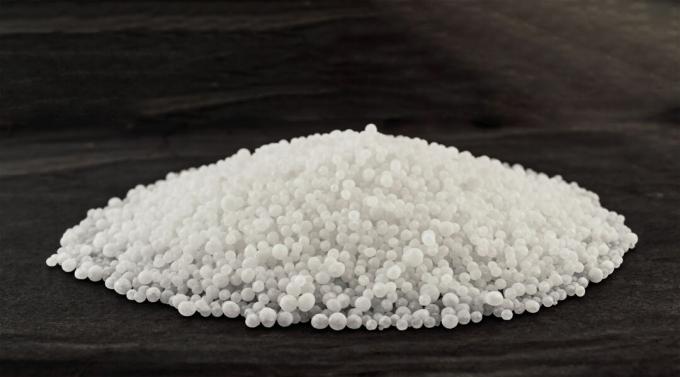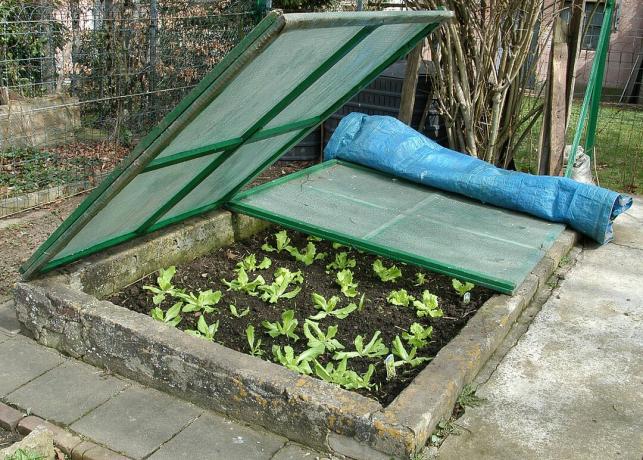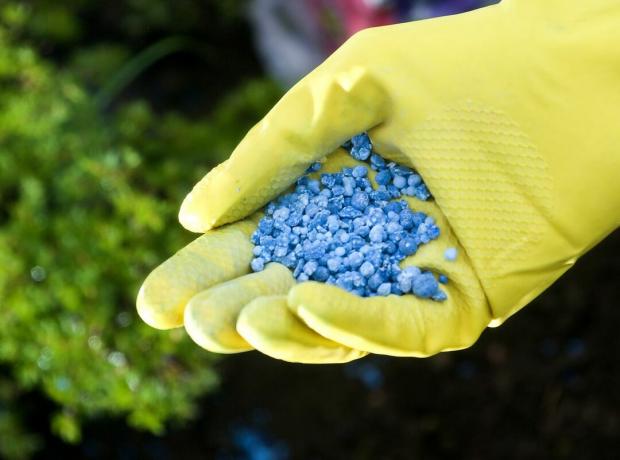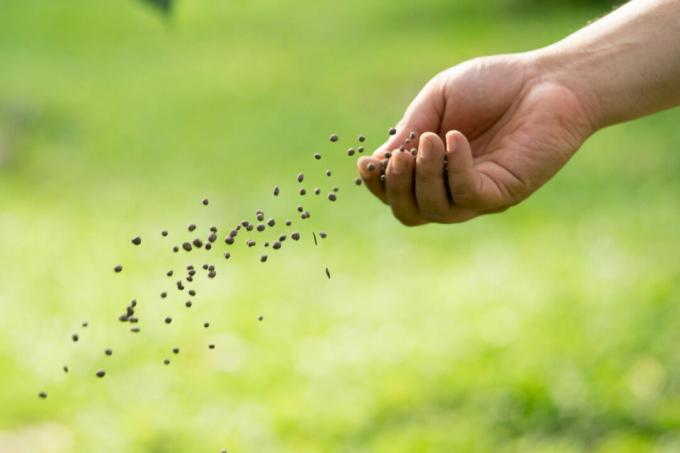Nitrogen fertilizers are ubiquitous, especially when it comes to lawns. But what do you need nitrogen fertilizers for? And maybe you can even do it yourself?

As the name suggests: The central component of nitrogen fertilizers is the main nutrient nitrogen (N). These fertilizers can either be produced synthetically or come from natural sources. However, regardless of the source, nitrogen is central to plant growth and yield.
contents
- Effect of nitrogen fertilizers
- Manufacture of nitrogen fertilizers
- Advantages and disadvantages of nitrogen fertilizers
-
Different nitrogen fertilizers: which ones are there?
- Ammonium nitrate
- urea
- Calcium cyanamide fertilizer
- Natural nitrogen fertilizers
- Liquid nitrogen fertilizers
- Blue grain
-
Nitrogen fertilizer for the lawn
- Lawn Nitrogen Fertilizer: Which Is The Best?
- Lawn nitrogen fertilizers: when to use?
- Lawn Nitrogen Fertilizer: How Much To Apply?
- Make nitrogen fertilizers yourself
Nitrogen is essential for plants to grow vigorously. The better the nitrogen supply in the soil and thus for the plants, the stronger the green color of the leaves. However, if there is not enough nitrogen in the soil, then you should help with nitrogen fertilization.
Effect of nitrogen fertilizers
Fertilizing with nitrogen is essential for important functions to take place in your beloved plants. Plants need nitrogen to do the following:
- Production of amino acids and proteins
- Promote the growth of shoots and leaves
- Structure of leaf green (chlorophyll) - an important part of photosynthesis
However, if a plant lacks nitrogen, it can lead to stunted growth. In addition, the leaves can lose their color and turn yellow, and even premature flowering may result.

But not only too little nitrogen can cause damage, too much of the nutrient can trigger excess symptoms. These symptoms include lumpy growth or delayed flowering. The leaves may continue to turn dark green, the plants become more susceptible to disease and frost, and the tissues of the plants become soft and spongy. The vegetative growth is promoted, but the plants are less stable.
Pure nitrogen fertilizers supply our plants with nitrogen, but unfortunately these are missing remaining nutrients that the plants need to survive - for example potassium, phosphorus and Trace elements. If you use pure nitrogen fertilizers, then your fertilization is very one-sided. Your plants will then be deficient in other nutrients.
In contrast to this are the complex fertilizers, which not only contain nitrogen, but also phosphorus (P) and potassium (K) - hence the name "NPK fertilizer“. With such universal fertilizers, the nutrient supply is more balanced than with pure nitrogen fertilizers.
Manufacture of nitrogen fertilizers
Most of the natural nitrogen in the soil comes from the air, because plants such as clover can fix the nitrogen from the air and introduce it into the soil. Clover is a so-called legume that lives in symbiosis with nodule bacteria. These nodule bacteria on the roots have the ability to fix nitrogen from the air. What only very few people know, however, is the fact that nitrogen can also be introduced into the soil by lightning strikes. Animal excrement can also be used as nitrogen fertilizer, such as manure, liquid manure or liquid manure. We can also store our kitchen waste on the compost convert it to a nitrogenous fertilizer or easily make herbal manure.

For example, there is a degradable nitrogen fertilizer guano which consists of the excrement of sea birds. This is mined on coasts and can be used as a nitrogen fertilizer. Guano is often found mixed with various fertilizers in order to increase the nitrogen content. In earlier times, a large part of the guano was imported from South America, but since nitrogen fertilizers can also be produced synthetically, the demand for this has fallen significantly.
Synthetically produced nitrogen fertilizers are produced using the Haber-Bosch process, in which the nitrogen from the atmosphere is converted into ammonia (NH3) is converted.
Advantages and disadvantages of nitrogen fertilizers
Nitrogen is essential for our plants, but it is not present in the soil in mineral form. This means that no nitrogen can be released from the weathering of the underground rock. However, the plants need nitrogen for their development - if there is no more nitrogen in the soil, satisfactory growth is no longer possible.
Unfortunately, incorrect and improper use can also have negative effects. Unfortunately, nitrogen or nitrate can be washed out very easily and end up in the groundwater. Thus it ends up in bodies of water and also in drinking water. Excessive nitrate levels in water can also be harmful to a wide variety of living things such as fish. However, too high a nitrate content in food is particularly dangerous for toddlers and babies, as this can lead to methaemoglobinemia - an insufficient supply of oxygen. This can ultimately even be life-threatening for small children and infants.
Features and benefits of a nitrogen fertilizer:
- Ensures adequate nitrogen supply
- Enables vigorous plant growth
- Promotes growth
- Supports stability and bloom
- Help prevent symptoms of nitrogen deficiency such as chlorosis
Different nitrogen fertilizers: which ones are there?
From natural to synthetically produced nitrogen fertilizers, practically everything can be found on the market. Below is a brief overview of the various products.
Ammonium nitrate
This fertilizer is also called ammonium nitrate or nitric acid ammonium, because it is the salt that is produced from ammonia and nitric acid (NH4NO3). In addition to being used as a fertilizer, ammonium nitrate is also used as an explosive. It is solid and readily soluble in water.
urea
The special thing about urea (CH4N2O) as a nitrogen fertilizer is the fact that urea can be partially absorbed through the leaves. Urea is also known under the name carbamide or carbonic acid amide.

Since urea is converted to ammonium very quickly, only a small amount of it is taken up via the roots.
Organic urea comes from mammalian urine, but it can also be made synthetically from ammonia and carbon dioxide. Urea has a high nitrogen content - with around 45% of this, it is an optimal nitrogen fertilizer. Urea is also the most widely used nitrogen fertilizer in the world.
Calcium cyanamide fertilizer
Calcium cyanamide is the trade name for fertilizers containing calcium cyanamide (CaN2) contain. A calcium cyanamide fertilizer contains around 20% nitrogen and around 55% calcium and can also kill plants and pests such as snails or wireworms. Because of this herbicidal effect, calcium cyanamide is also often used to combat moss on lawns. You can also treat beds with it before sowing to remove unwanted seedlings. Make sure you never use more than 30 grams per square meter - this would lead to overdosing and burns. Calcium cyanamide is also often used on the compost to accelerate the rotting process.
Calcium cyanamide is a rather slow-acting basic fertilizer, which, however, also releases the poisonous hydrogen cyanide during its decomposition. Therefore, you should be aware that the use of calcium cyanamide has an effect on the pH value - it lowers it.
Natural nitrogen fertilizers
The most traditional nitrogen fertilizers are definitely manure, slurry and liquid manure from different animals. But also legumes like peas (Pisum sativum) or Haricot beans (Phaseolus vulgaris) bring nitrogen into the soil. With their nodule bacteria, these plants are able to fix nitrogen from the air in the soil.
When you think of manure, most likely think of cow manure, but manure from other farm animals can also be used as fertilizer. But you should always pay attention to the different nutrient ratios.

Manure is particularly suitable for cold frames, because when it decomposes, heat is generated, which is exactly the right thing in the cool spring. Horse manure in particular gives off a lot of heat when rotting and is ideal for filling cold frames.
Liquid nitrogen fertilizers
Natural liquid fertilizers primarily include liquid manure and manure, but many mineral nitrogen fertilizers can also be dissolved in water and used in liquid form. Most liquid fertilizers contain nitrogen, even in special fertilizers for certain plants you will always find nitrogen, ideally tailored to specific groups of plants and their needs. Such fertilizers are considered universal fertilizers, as they always contain several nutrients and do not consist entirely of nitrogen.
For this reason, however, these fertilizers cannot be called classic nitrogen fertilizers. Pure nitrogen fertilizers supply the plants with nitrogen, but only with this and no other nutrient.
Many gardeners prefer liquid fertilizers because they can be brought in with the irrigation water and do not require laborious work into the soil. It is also possible to use liquid fertilizer for foliar fertilization, and nitrogen (urea) can also be absorbed through the leaves. However, this should only be used to compensate for short-term nutrient peaks - in principle, nitrogen uptake should take place via the plant roots.
Blue grain
Blue grain is a mineral compound fertilizer, also called NPK fertilizer. The abbreviation “NPK” stands for the three main components of this fertilizer: nitrogen, phosphorus and potassium. The blue grain is available as solid blue granules. It can also be dissolved in water and used for liquid fertilization.

Opinions are divided about the blue grain, many swear by this mineral fertilizer, others do not want to hear about it. More to Blue grain find out here.
Nitrogen fertilizer for the lawn
Our green lawns also need an additional nutrient kick every now and then in order to be able to grow properly. Nitrogen is particularly important for growth and for keeping your lawn in its rich green color.
Lawn Nitrogen Fertilizer: Which Is The Best?
There are currently many lawn fertilizers on the market that differ in their nutritional composition. However, these are not pure nitrogen fertilizers, but rather complex fertilizers. Always pay attention to a higher potassium content in an autumn lawn fertilizer, because this is extremely important for frost resistance. The fertilizers should also have a suitable NPK ratio. If you are looking for a long-term organic fertilizer for your lawn, you can find ours Plantura organic lawn fertilizer insert.
Lawn nitrogen fertilizers: when to use?
If you use mineral nitrogen fertilizers, you get a quick effect, but for During the main growth period, sprouting occurs again and again, but not one uniform growth. Therefore, you should apply nitrogen to the lawn in spring or autumn, when the main growing season is over. With autumn lawn fertilization, however, you should rely on a complex fertilizer with a high potassium content for frost resistance, not on a high supply of nitrogen.
If your lawn has survived the winter well, a slow release fertilizer at the beginning of May is sufficient. However, if the sward shows signs of damage after the winter, you should regenerate one quickly Use soluble nitrogen fertilizer in April and another slow release fertilizer around June use.

In addition, autumn fertilization supports your lawn so that it can survive the winter. Rather, rely on a potassium-accentuated autumn lawn fertilizer, because too much nitrogen leads to unwanted growth in winter. Autumn fertilization is best done in October on an overcast day. More about the optimal Lawn fertilization you can also find out in our special article.
Lawn Nitrogen Fertilizer: How Much To Apply?
But how much should you now use for fertilization? For example, if you have our Plantura Organic lawn fertilizer, which is not a classic nitrogen fertilizer, with an NPK ratio of 8 - 1 - 6, the following application quantities are recommended:
- 40 - 60 g / m² as maintenance and care fertilizer in spring and early summer
- 70 g / m² as regeneration fertilization after verticulating in spring
Our Plantura organic autumn lawn fertilizer has an NPK ratio of 5 - 1 - 9. For optimal autumn fertilization, you should apply 50 to 80 grams per square meter of lawn in autumn.
Make nitrogen fertilizers yourself
Among the simplest self-made nitrogen fertilizers are certainly the compost as well as manure. It is best for every gardener to get a compost and use it to produce high-quality fertilizer for their own garden. It is basically very easy to compost garden and kitchen waste such as vegetable scraps, coffee grounds, fruit scraps and the like. But be careful with garden waste: only add plant parts to the compost that are free from Pathogens are, and also not weeds, that develop many seeds or multiply via strong roots and spread. The bindweed (Convolvulus arvensis) has no place on the compost, for example.
You can also use plant manure for fertilization, such as a Nettle manure. Such plant manure is extremely easy to produce and provides the soil and plants with the necessary nitrogen. The practical thing about manure is especially its wide range of applications, because nettle manure, for example, is not just one Nitrogen fertilizer, it also strengthens the plants and can be used for pest control - a real all-round talent.
